Predicting the Width of Corrosion-Induced Cracks in Reinforced Concrete Using a Damage Model Based on Fracture Mechanics
Abstract
1. Introduction
2. Numerical Analysis Based on Fracture Mechanism
2.1. Outline
2.2. Corrosion Expansion Model
3. Validation of the Proposed Model
3.1. Outline
3.2. How the Shape of Reinforcing Bars Affects Corrosion Cracks
3.2.1. Analysis Conditions
3.2.2. Results
3.3. How Stirrups Affect Corrosion Cracking
3.3.1. Analysis Conditions
3.3.2. Results: Effect of the Existence of Stirrups on the Width of Corrosion Cracks
3.3.3. Results: Effect of the Numbers of Main Reinforcement Bars on the Width of the Corrosion Cracks
4. Experimental Numerical Study of Corrosion Cracks and their Reproduction
4.1. Outline
4.2. Specimen
4.3. Results for Crack Width due to Corrosion
4.4. Comparison of Experimental and Numerical Results
5. Conclusions
Author Contributions
Funding
Conflicts of Interest
References
- Ministry of Land, Infrastructure, Transport and Tourism. White Paper on Land, Infrastructure, Transport and Tourism in Japan; Ministry of Land, Infrastructure, Transport and Tourism: Japan, Tokyo, 2019; pp. 110–112.
- Castro, P.; Véleva, L.; Balancán, M. Corrosion of reinforced concrete in a tropical marine environment and in accelerated tests. Constr. Build. Mater. 1997, 11, 75–81. [Google Scholar] [CrossRef]
- Santhanam, M.; Otieno, M. Deterioration of concrete in the marine environment. In Marine Concrete Structures; Woodhead Publishing: Cambridge, UK, 2016; pp. 137–149. [Google Scholar]
- Ueli, M. Angst Durable concrete structures: Cracks & corrosion and corrosion & cracks. In Proceedings of the 10th International Conference on Fracture Mechanics of Concrete and Concrete Structures, Bayonne, France, 23–26 June 2019; pp. 1–10. [Google Scholar]
- Bossio, A.; Bellucci, F. Environmental degradation of reinforced concrete structures. Corros. Rev. 2019, 37, 1–2. [Google Scholar] [CrossRef]
- Marcotte, T.D.; Hansson, C.M. Corrosion products that form on steel within cement paste. Mater. Struct. 2007, 40, 325–340. [Google Scholar] [CrossRef]
- Vidal, T.; Castel, A.; François, R. Corrosion process and structural performance of a 17 year old reinforced concrete beam stored in chloride environment. Cem. Concr. Res. 2007, 37, 1551–1561. [Google Scholar] [CrossRef]
- Arai, K.; Hattori, A.; Miyagawa, T. Mechanism and prediction of cover concrete spalling due to reinforcement corrosion. J. Jpn. Soc. Civ. Eng. 2005, 69, 209–222. [Google Scholar]
- Du, Y.; Cullen, M.; Li, C. Structural performance of RC beams under simultaneous loading and reinforcement corrosion. Constr. Build. Mater. 2013, 38, 472–481. [Google Scholar] [CrossRef]
- Kato, E.; Hamada, Y.; Iwanami, M.; Yokota, H. Influence of localized corrosion of steel bars on structural performance of concrete beam. In Proceedings of the 1st International Symposium on Life-Cycle Civil Engineering, Lake Como, Italy, 11–14 June 2008; Volume 47, pp. 57–82. [Google Scholar]
- ACI. Committee 201. Guide for Conducting a Visual Inspection of Concrete in Service; ACI 201: Farmington Hills, MI, USA, 2008; 1R-08. [Google Scholar]
- Shodja, H.M.; Kiani, K.; Hashemian, A. A model for the evolution of concrete deterioration due to reinforcement corrosion. Math. Comput. Model. 2010, 52, 1403–1422. [Google Scholar] [CrossRef]
- Val, D.V.; Chernin, L.; Stewart, M.G. Experimental and numerical investigation of corrosion-induced cover cracking in reinforced concrete structures. J. Struct. Eng. 2009, 135, 376–385. [Google Scholar] [CrossRef]
- Lu, C.H.; Liu, R.G.; Jin, W.L. A model for predicting time to corrosion-induced cover cracking in reinforced concrete structures. In Fracture Mechanics of Concrete and Concrete Structures Assessment, Durability, Monitoring and Retrofitting of Concrete Structures; CRC Press: Boca Raton, FL, USA, 2010; pp. 967–975. [Google Scholar]
- Lau, I. Time-Dependent Reliability Analysis of Corrosion-Induced Concrete Cracking Based on Fracture Mechanics Criteria. Ph.D. Thesis, RMIT University, Melbourne, Australia, 2019. [Google Scholar]
- Lau, I.; Li, C.-Q.; Fu, G. Prediction of time to corrosion-induced concrete cracking based on fracture mechanics criteria. J. Struct. Eng. 2019, 145, 04019069. [Google Scholar] [CrossRef]
- Chernin, L.; Val, D.V. Prediction of corrosion-induced cover cracking in reinforced concrete structures. Constr. Build. Mater. 2011, 25, 1854–1869. [Google Scholar] [CrossRef]
- Coccia, S.; Imperatore, S.; Rinaldi, Z. Influence of corrosion on the bond strength of steel rebars in concrete. Mater. Struct. 2016, 49, 537–551. [Google Scholar] [CrossRef]
- Shen, J.; Gao, X.; Li, B.; Du, K.; Jin, R.; Chen, W.; Xu, Y. Damage evolution of RC beams under simultaneous reinforcement corrosion and sustained load. Materials 2019, 12, 627. [Google Scholar] [CrossRef] [PubMed]
- Song, L.; Fan, Z.; Hou, J. Experimental and analytical investigation of the fatigue flexural behavior of corroded reinforced concrete beams. Int. J. Concr. Struct. Mater. 2019, 13, 24. [Google Scholar] [CrossRef]
- Bossio, A.; Fabbrocino, F.; Monetta, T.; Lignola, G.P.; Prota, A.; Manfredi, G.; Bellucci, F. Corrosion effects on seismic capacity of reinforced concrete structures. Corros. Rev. 2019, 37, 45–56. [Google Scholar] [CrossRef]
- Cui, Z.; Alipour, A.; Shafei, B. Structural performance of deteriorating reinforced concrete columns under multiple earthquake events. Eng. Struct. 2019, 191, 460–468. [Google Scholar] [CrossRef]
- Apostolopoulos, C.A.; Koulouris, K.F.; Apostolopoulos, A.C. Correlation of surface cracks of concrete due to corrosion and bond strength (between Steel Bar and Concrete). Adv. Civ. Eng. 2019, 2019, 3438743. [Google Scholar] [CrossRef]
- Kurumatani, M.; Anzo, H.; Soma, Y.; Okazaki, S. Analysis of 3D crack propagation due to steel corrosion using damage model. Trans. Jpn. Soc. Comput. Eng. Sci. 2019, 2019, 20190007. [Google Scholar]
- Kurumatani, M.; Nemoto, Y.; Okazaki, S.; Hirose, S. Simulation of crack-paths formed in concrete around deformed tension bar. Trans. Jpn. Soc. Comput. Eng. Sci. 2014, 2014, 20140008. [Google Scholar]
- Bažant, Z.P. Physical model for steel corrosion in concrete sea structures—Application. J. Struct. Div. 1979, 105, 1155–1166. [Google Scholar]
- Lin, X.; Peng, M.; Lei, F.; Tan, J.; Shi, H. Analytical model of cracking due to rebar corrosion expansion in concrete considering the structure internal force. AIP Adv. 2017, 7, 125328. [Google Scholar] [CrossRef]
- Tsutsumi, T.; Matsushima, M.; Murakami, Y.; Seki, H. Study on crack models caused by pressure due to corrosion products. J. Jpn. Soc. Civ. Eng. 1996, 30, 159–166. [Google Scholar]
- De Vree, J.H.P.; Brekelmans, W.A.M.; van Gils, M.A.J. Comparison of nonlocal approaches in continuum damage mechanics. Comput. Struct. 1995, 55, 581–588. [Google Scholar] [CrossRef]
- Nishizawa, A.; Takaya, S.; Nakamura, S.; Miyagawa, T. Influence of steel corrosion products in concrete on crack opening weight loss of corrosion. Proc. Jpn. Concr. Inst. 2013, 35, 1051–1056. [Google Scholar]
- Akashiro, K.; Mitamura, H.; Watanabe, T.; Kishi, T. Effect of bond characteristics of steel bar on fatigue property of RC slab. Proc. Jpn. Concr. Inst. 2010, 32, 727–732. [Google Scholar]
- Lukuan, Q.; Seki, H. Analytical study on crack generation situation and crack width due to reinforcing steel corrosion. Proc. Jpn. Concr. Inst. 2001, 32, 727–732. [Google Scholar]
- Qiao, D.; Nakamura, H.; Tran, K.K.; Yamamoto, Y.; Miura, T. Experimental and analytical evaluation of concrete cover spalling behavior due to local corrosion. J. Struct. Eng. 2015, 61, 707–714. [Google Scholar]
- Takaya, S.; Nakamura, S.; Yamamoto, T.; Miyagawa, T. Influence of Steel corrosion products in concrete on crack opening weight loss of corrosion. J. Jpn. Soc. Civ. Eng. 2013, 69, 154–165. [Google Scholar]
- Suzuki, M.; Fukuura, N.; Maruya, T. Establishment of a coupled analysis between structure and reinforcement corrosion for predicting deterioration of reinforced concrete structure by salt damage. J. Jpn. Soc. Civ. Eng. 2014, 70, 301–319. [Google Scholar]
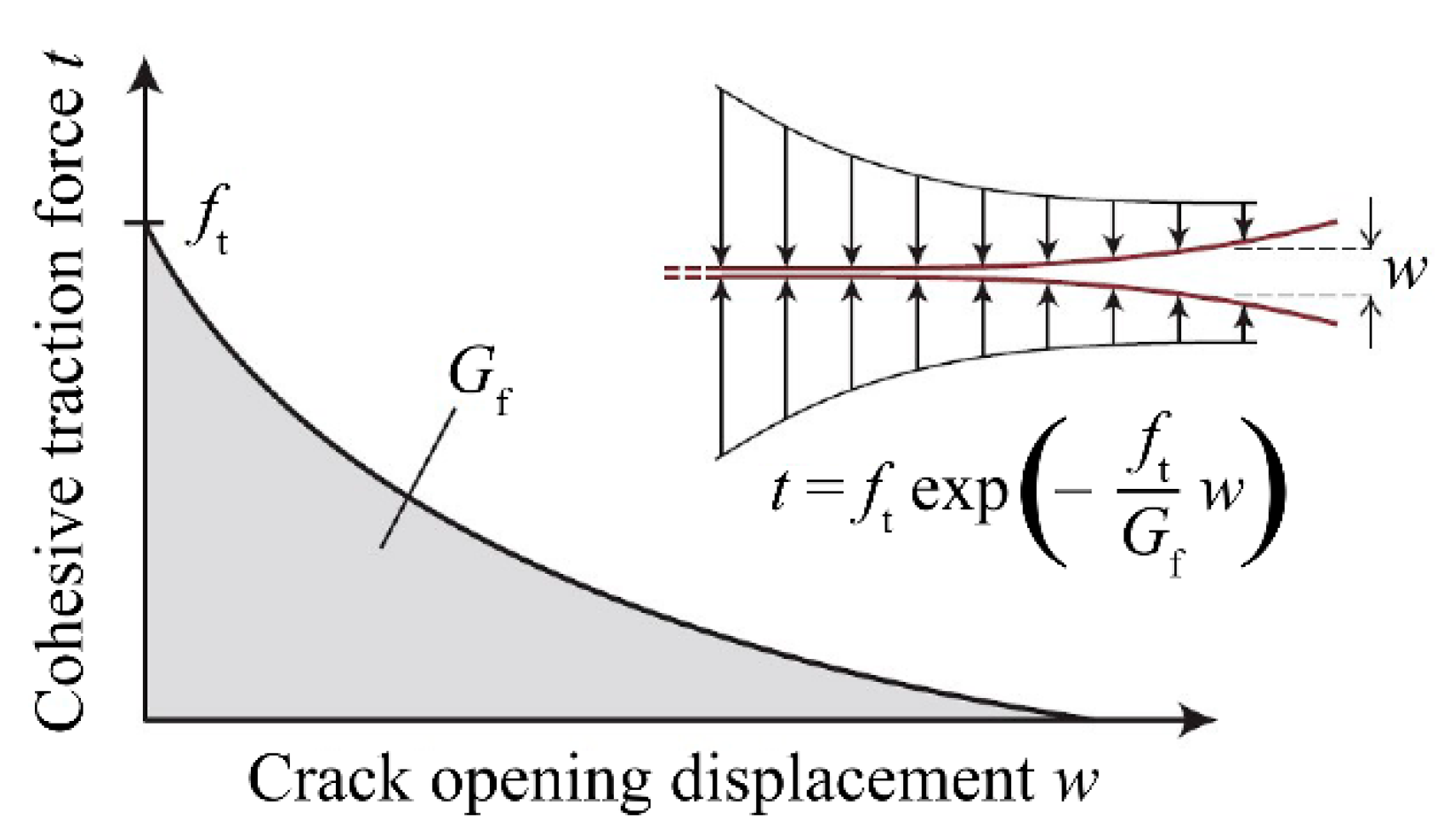
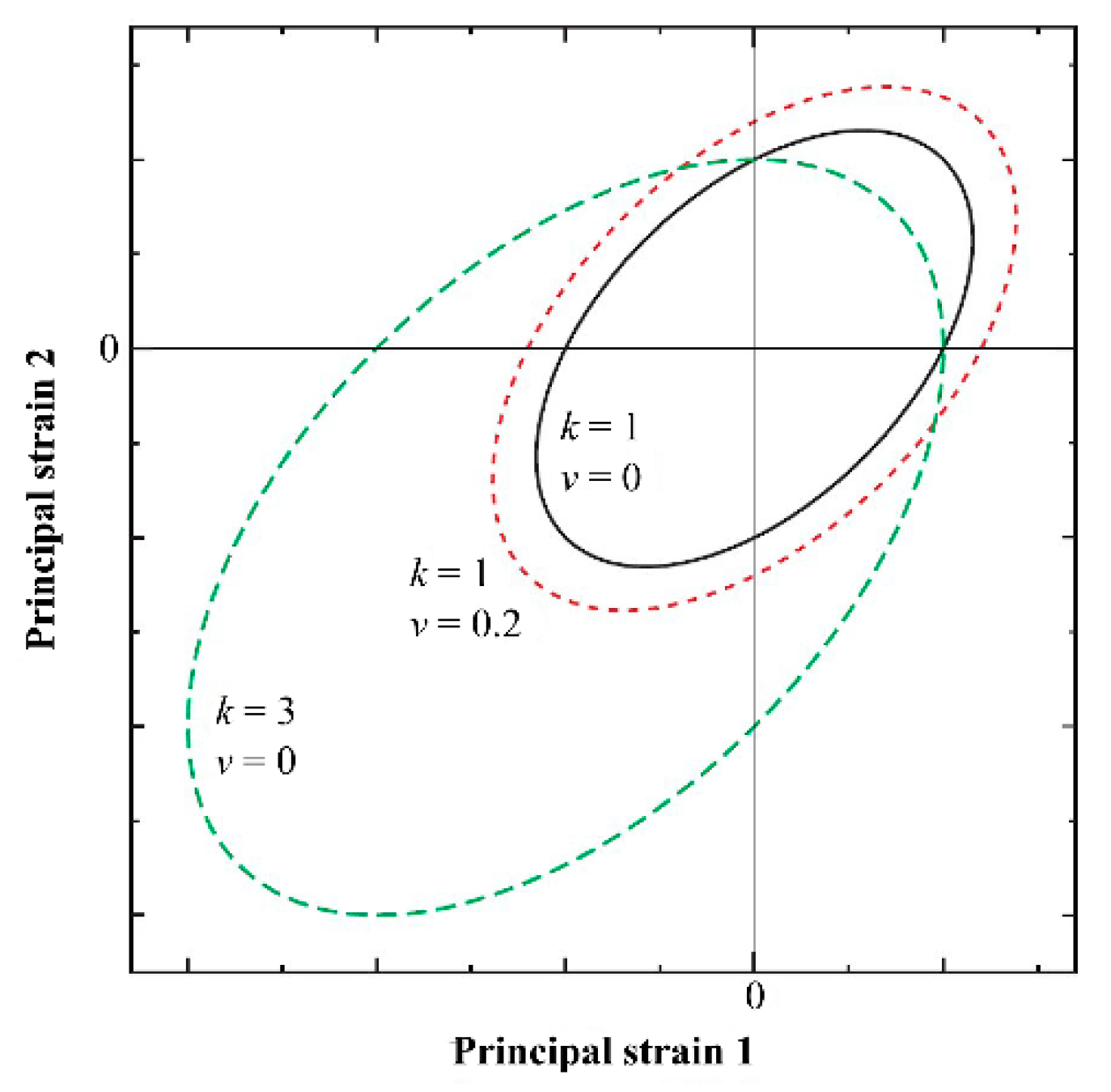

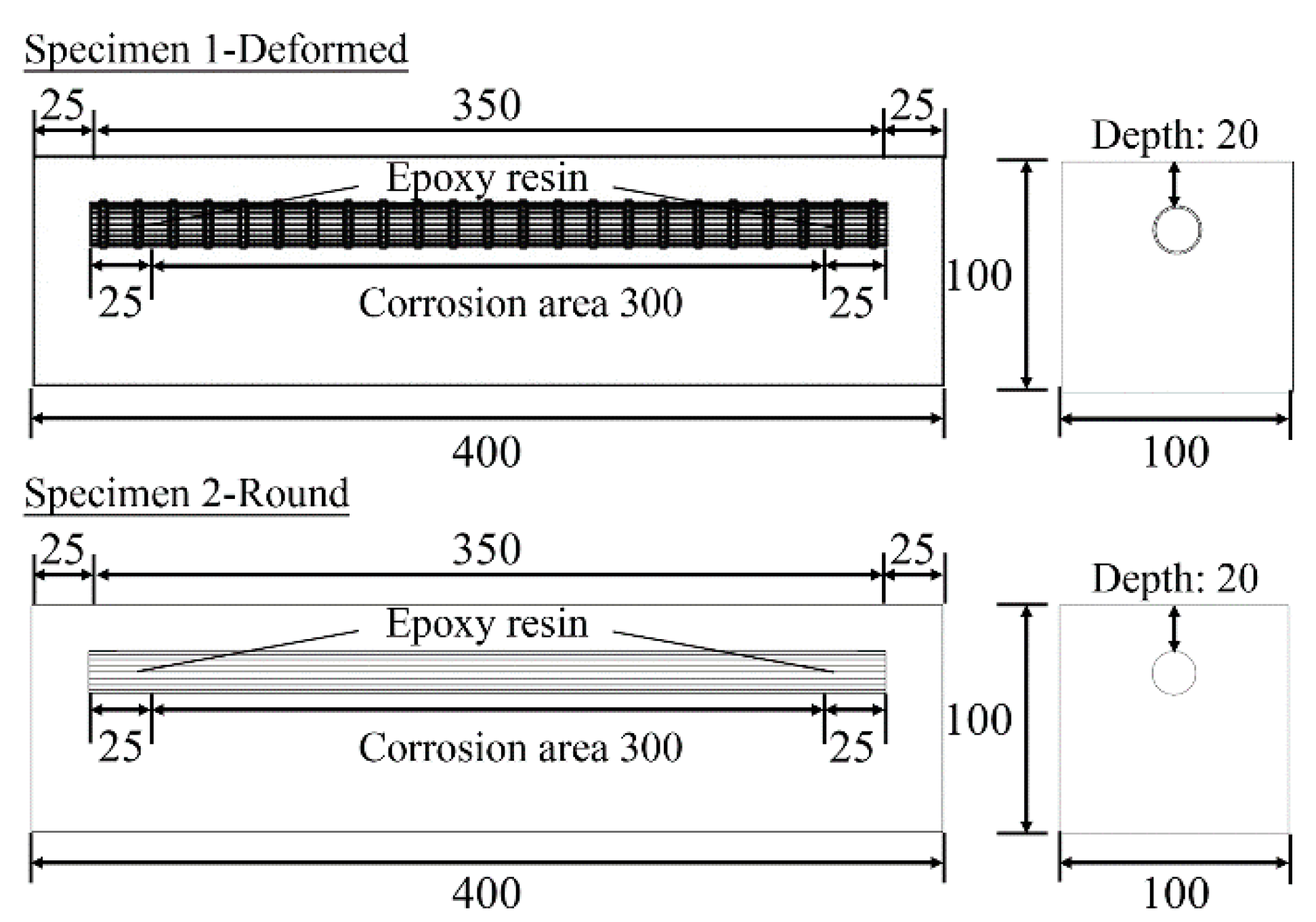

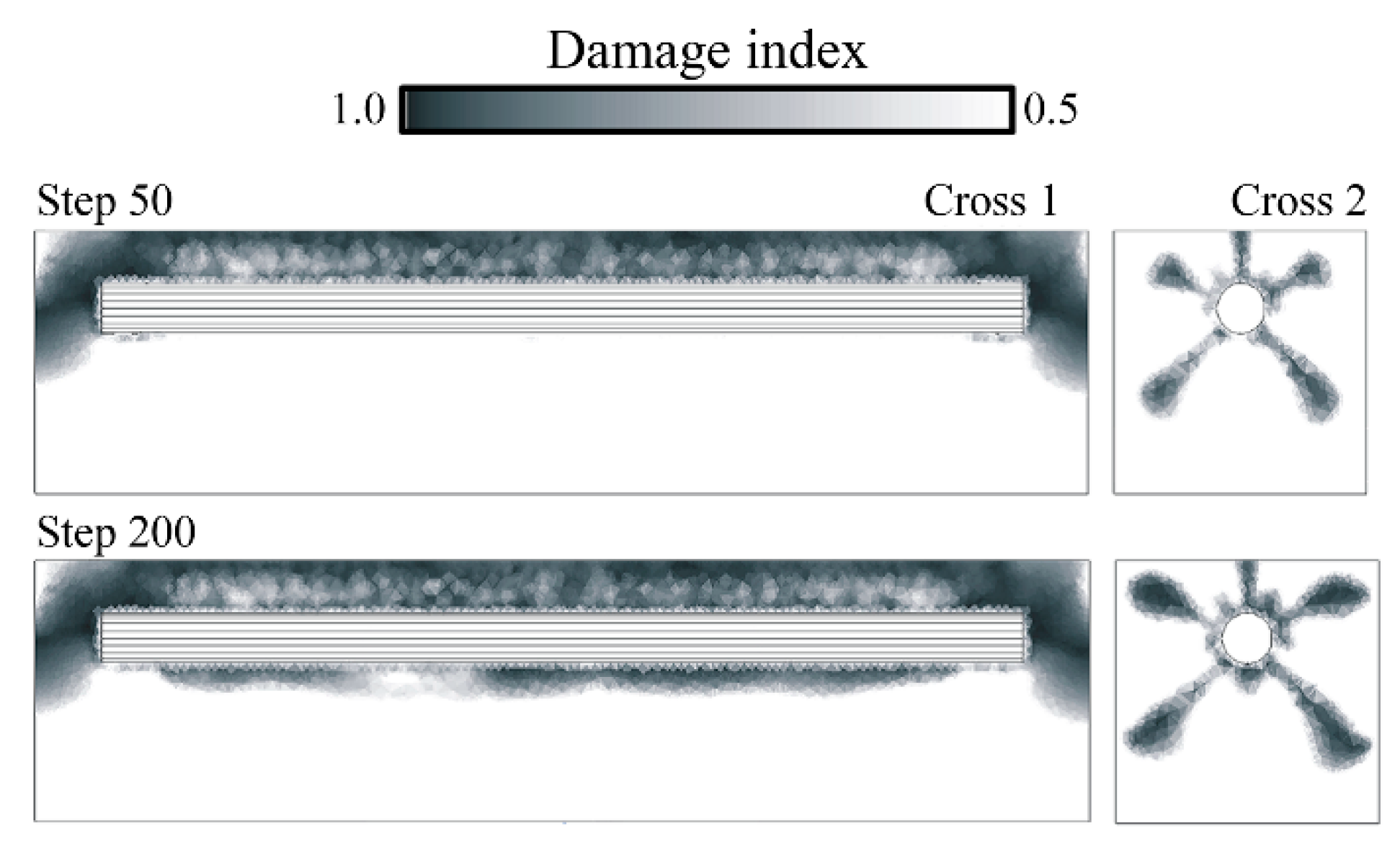
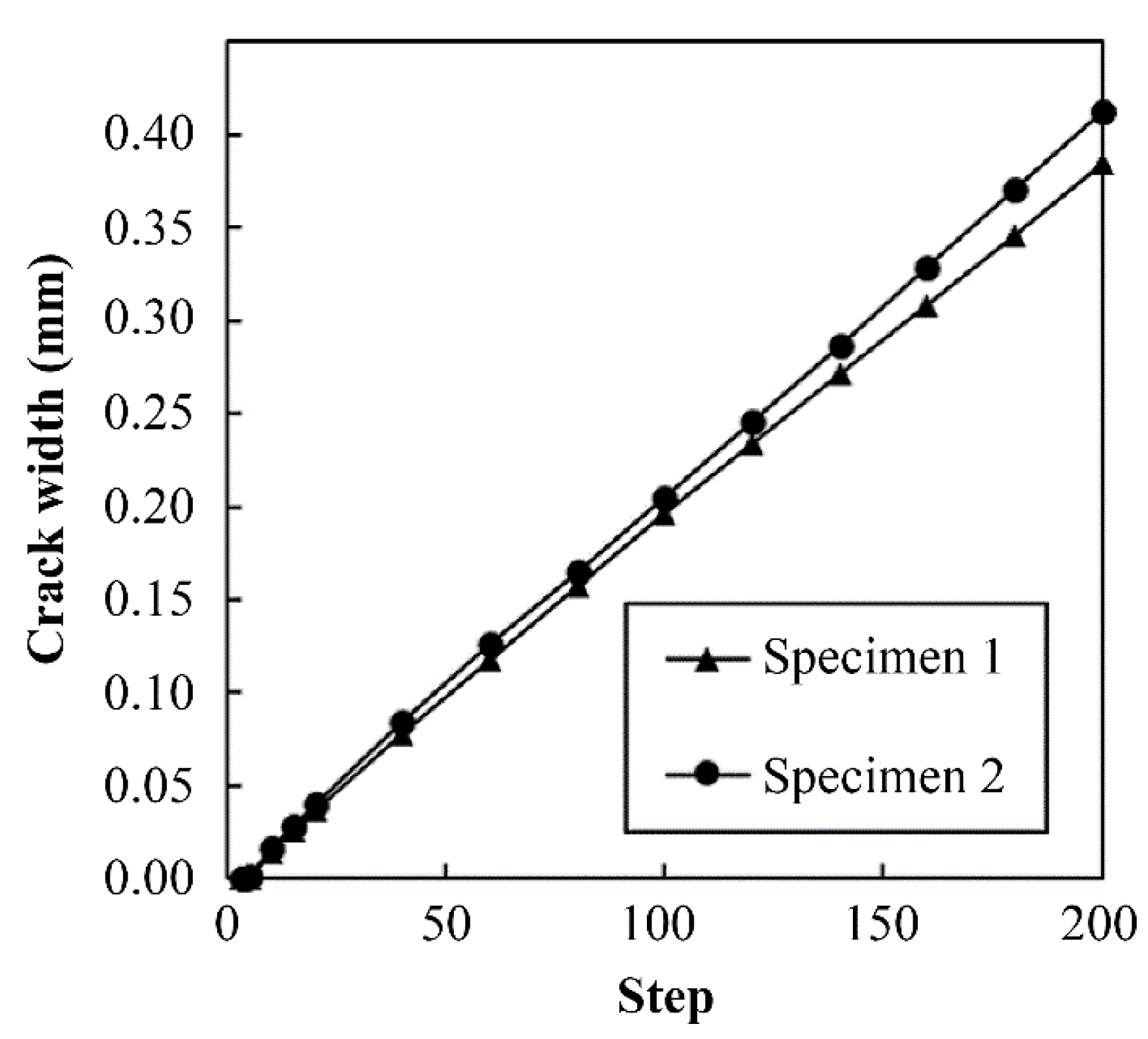
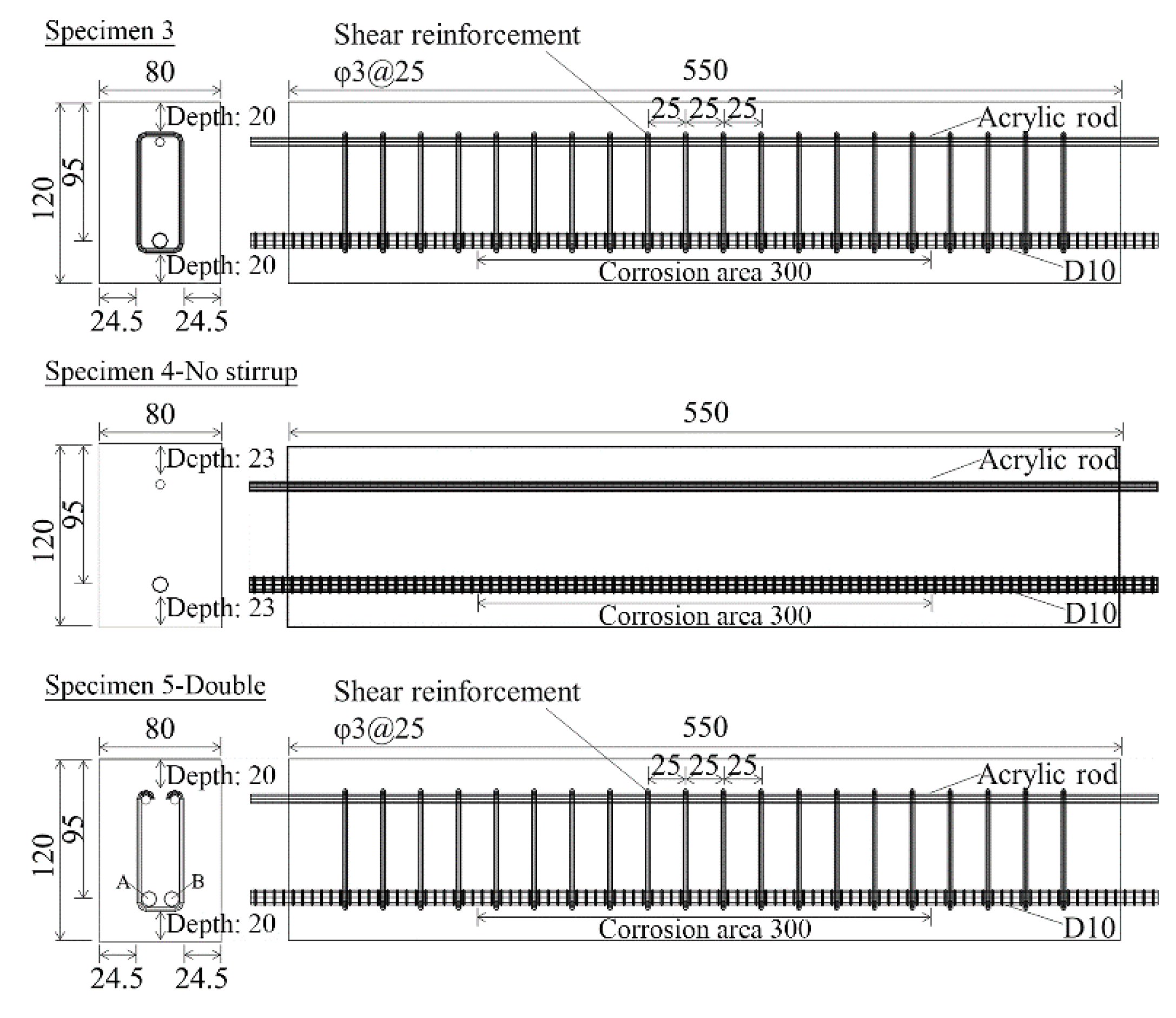
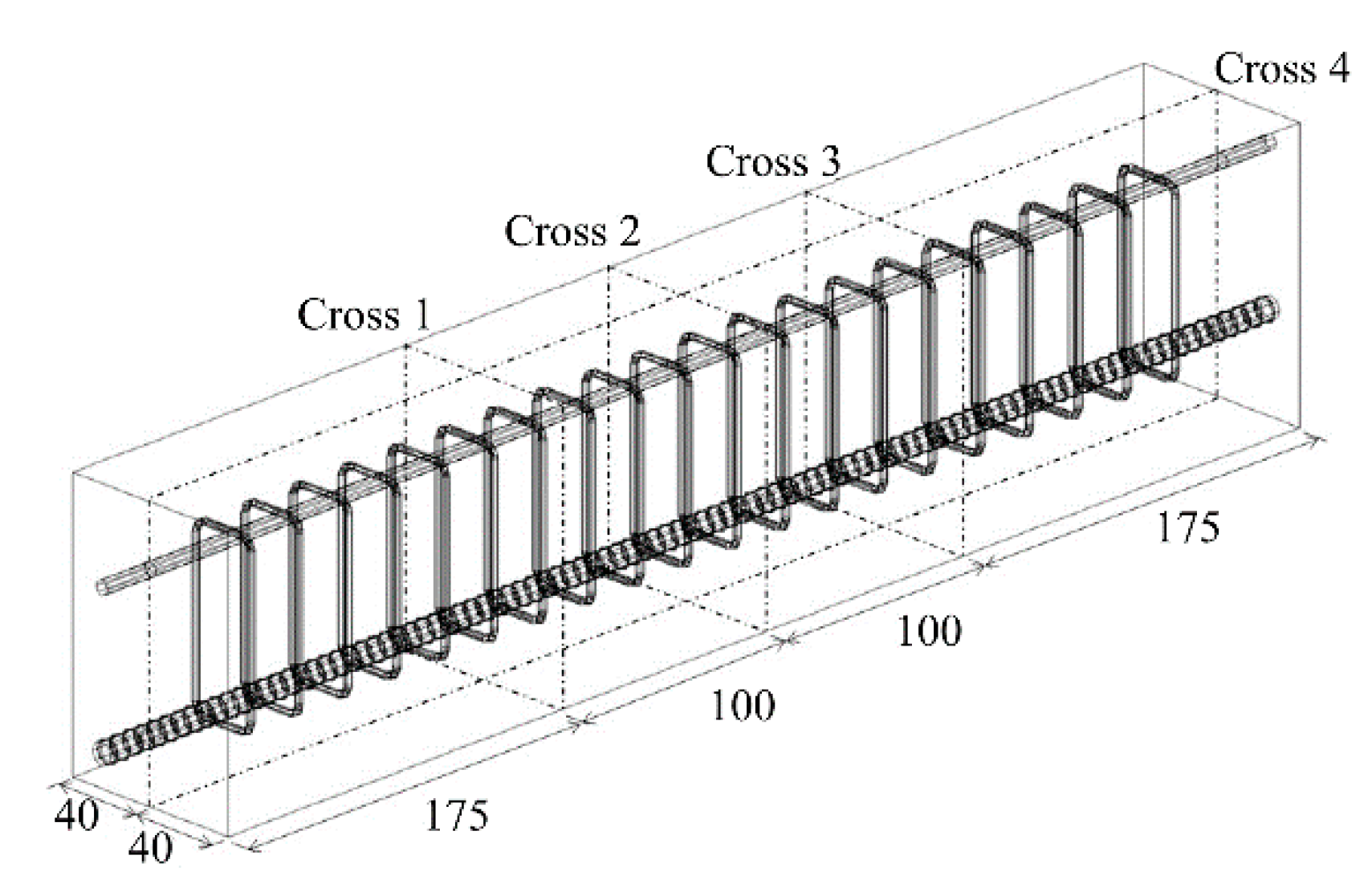

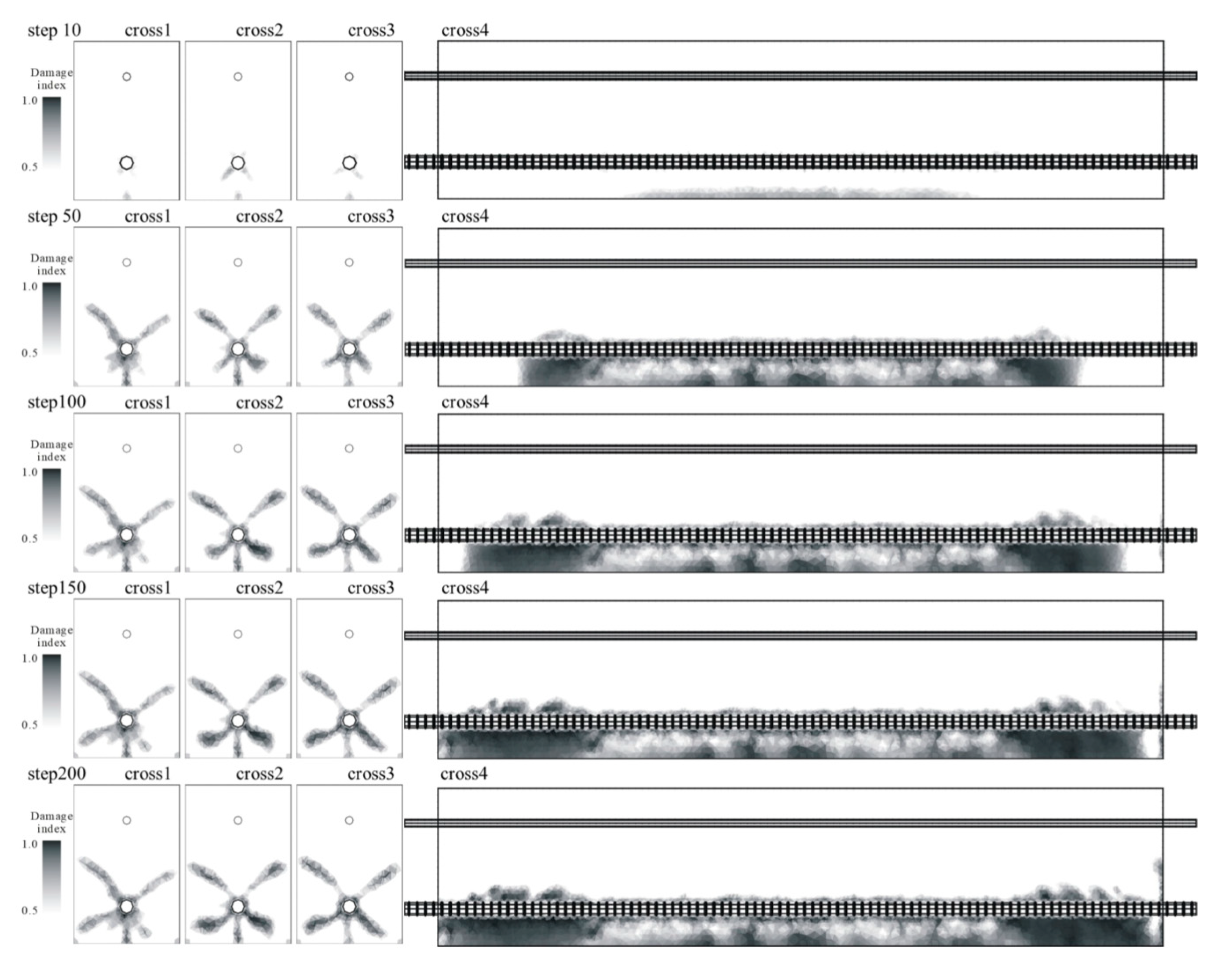
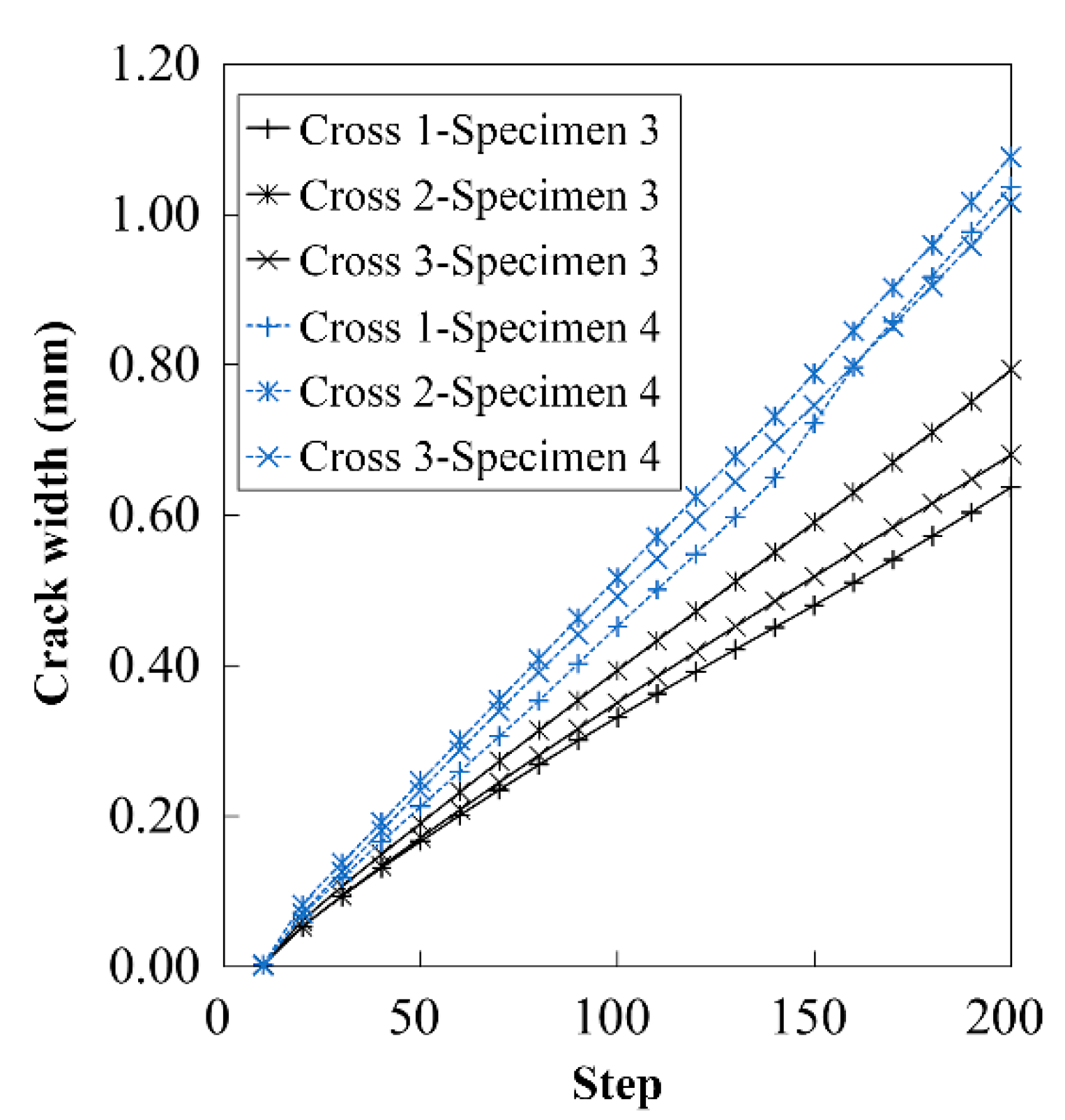

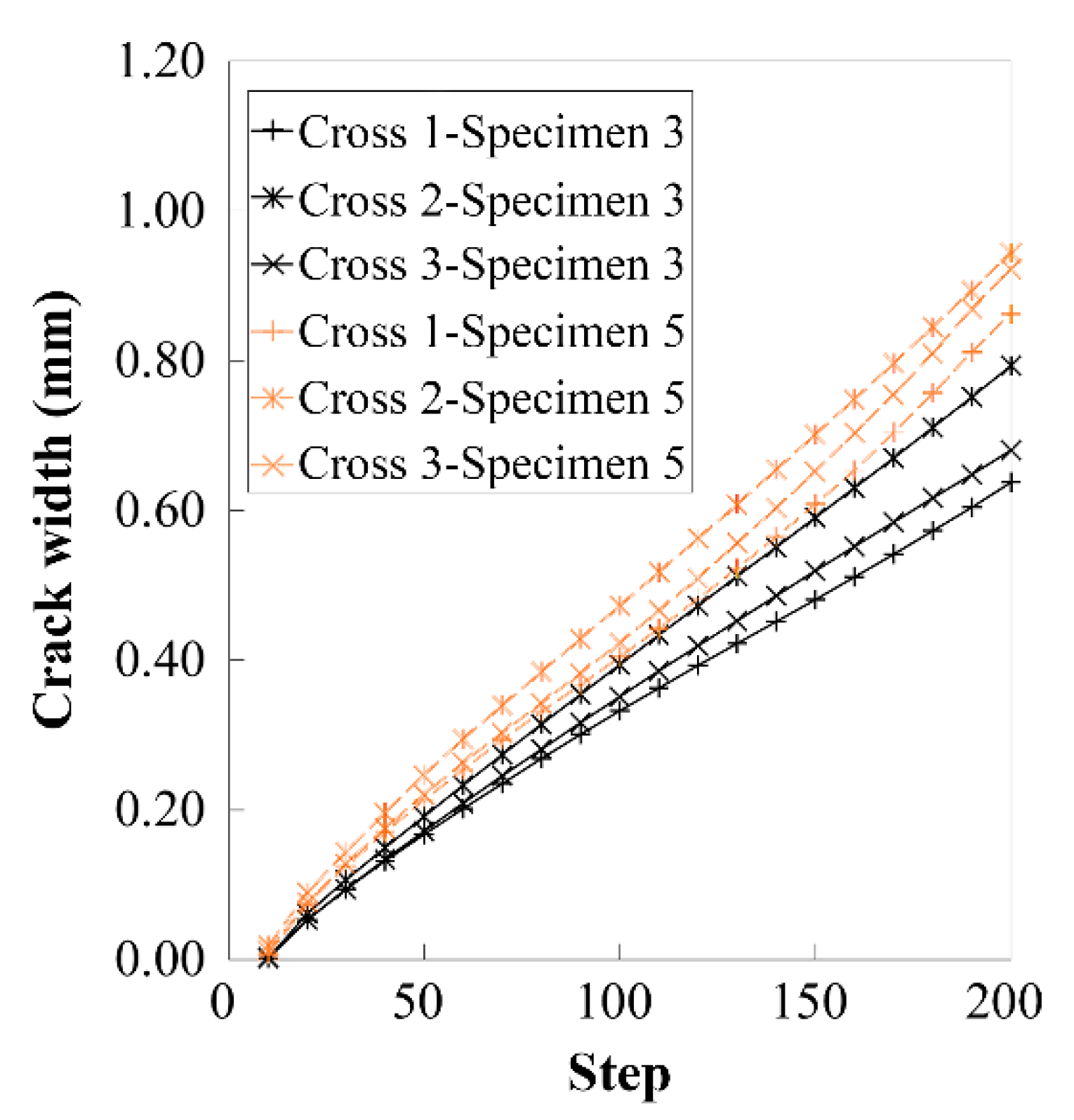
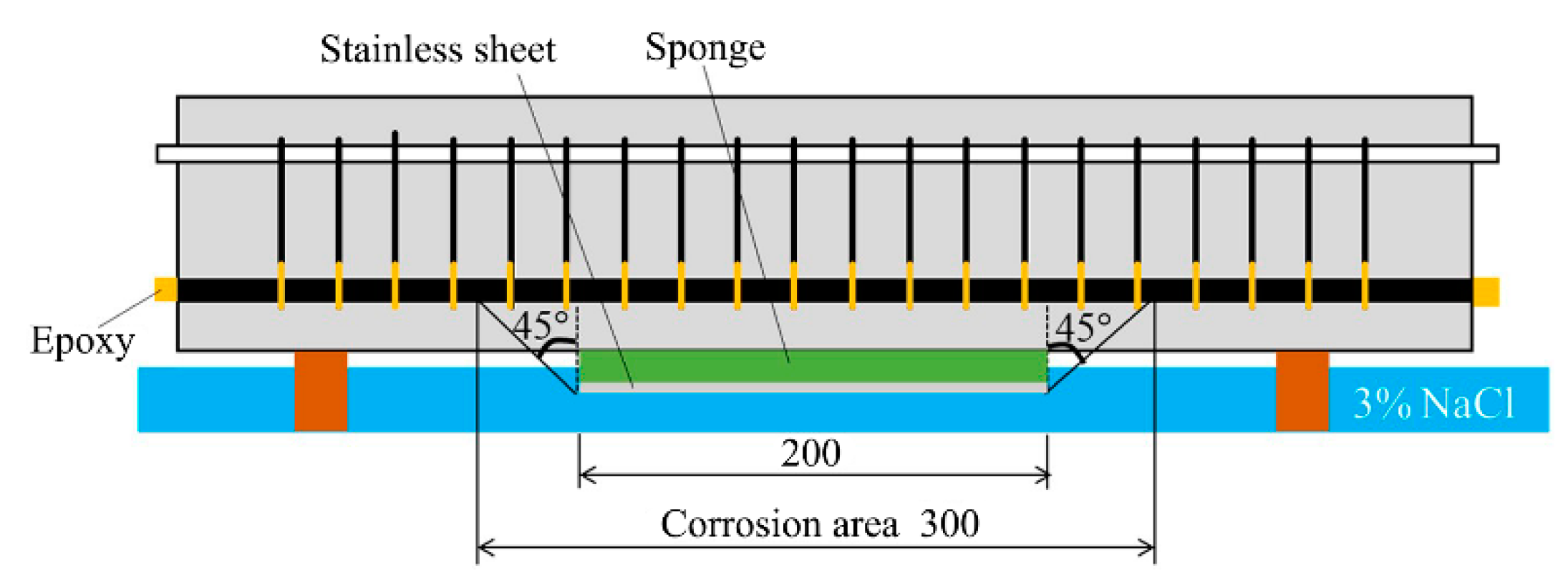
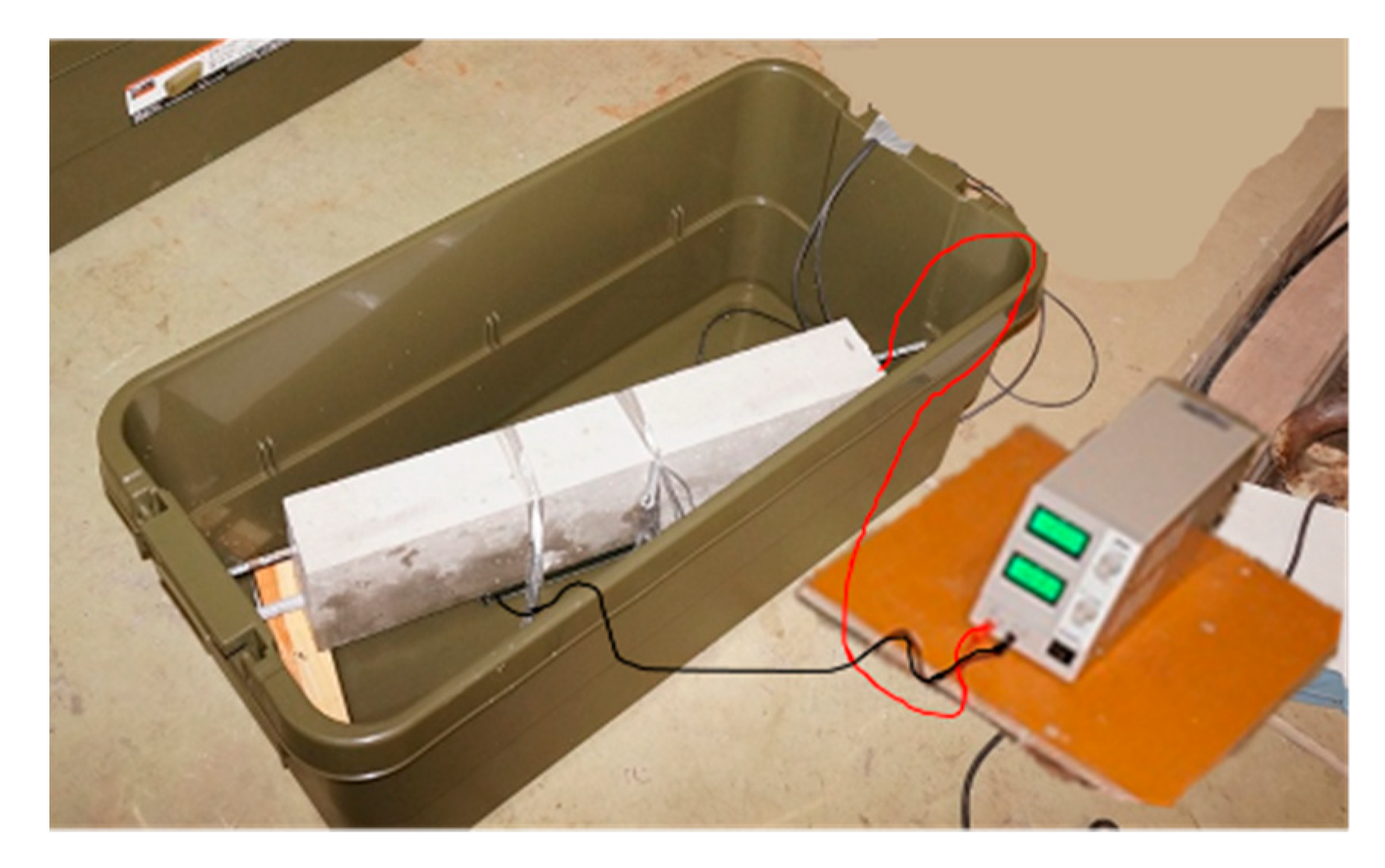

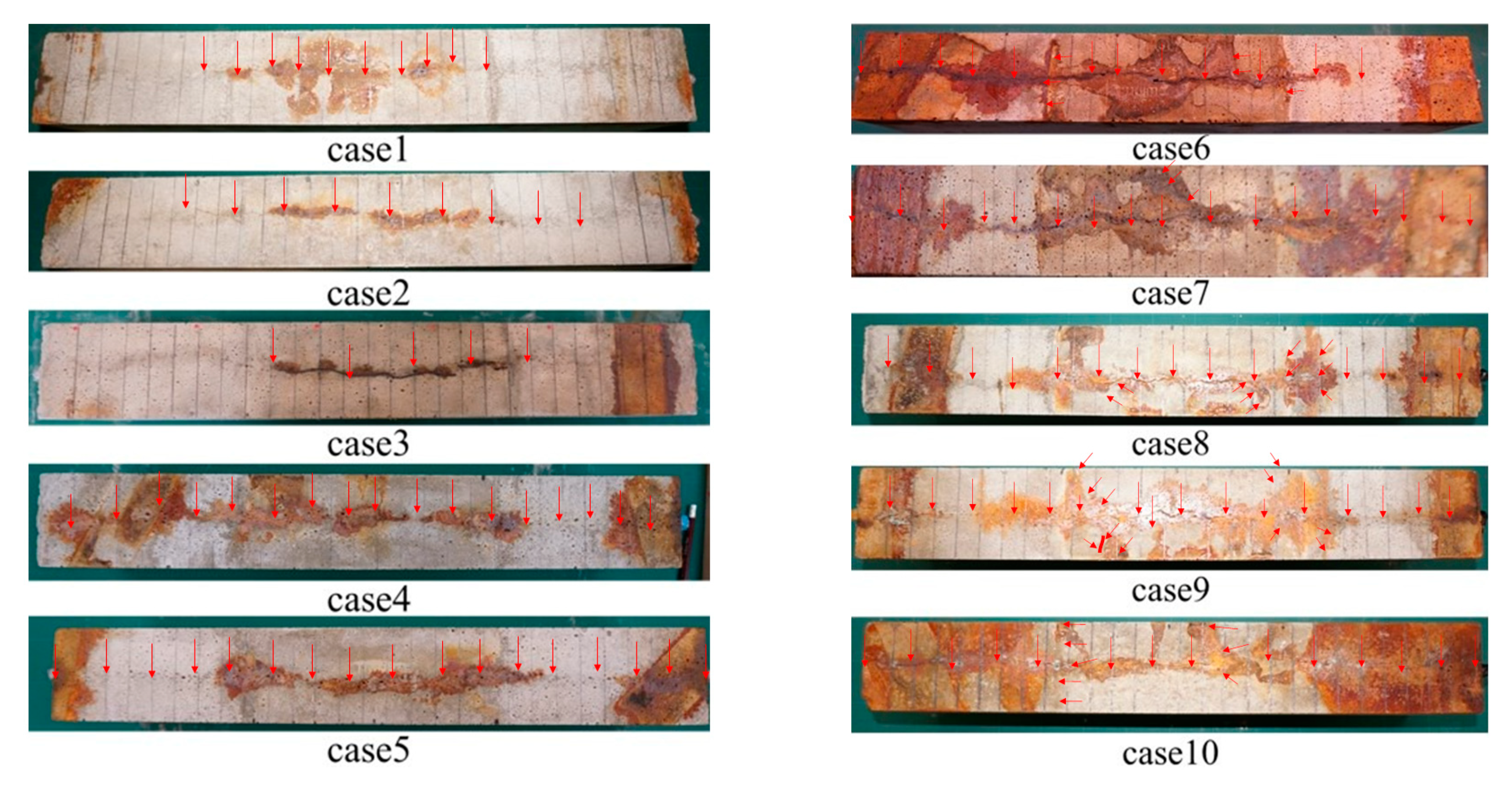
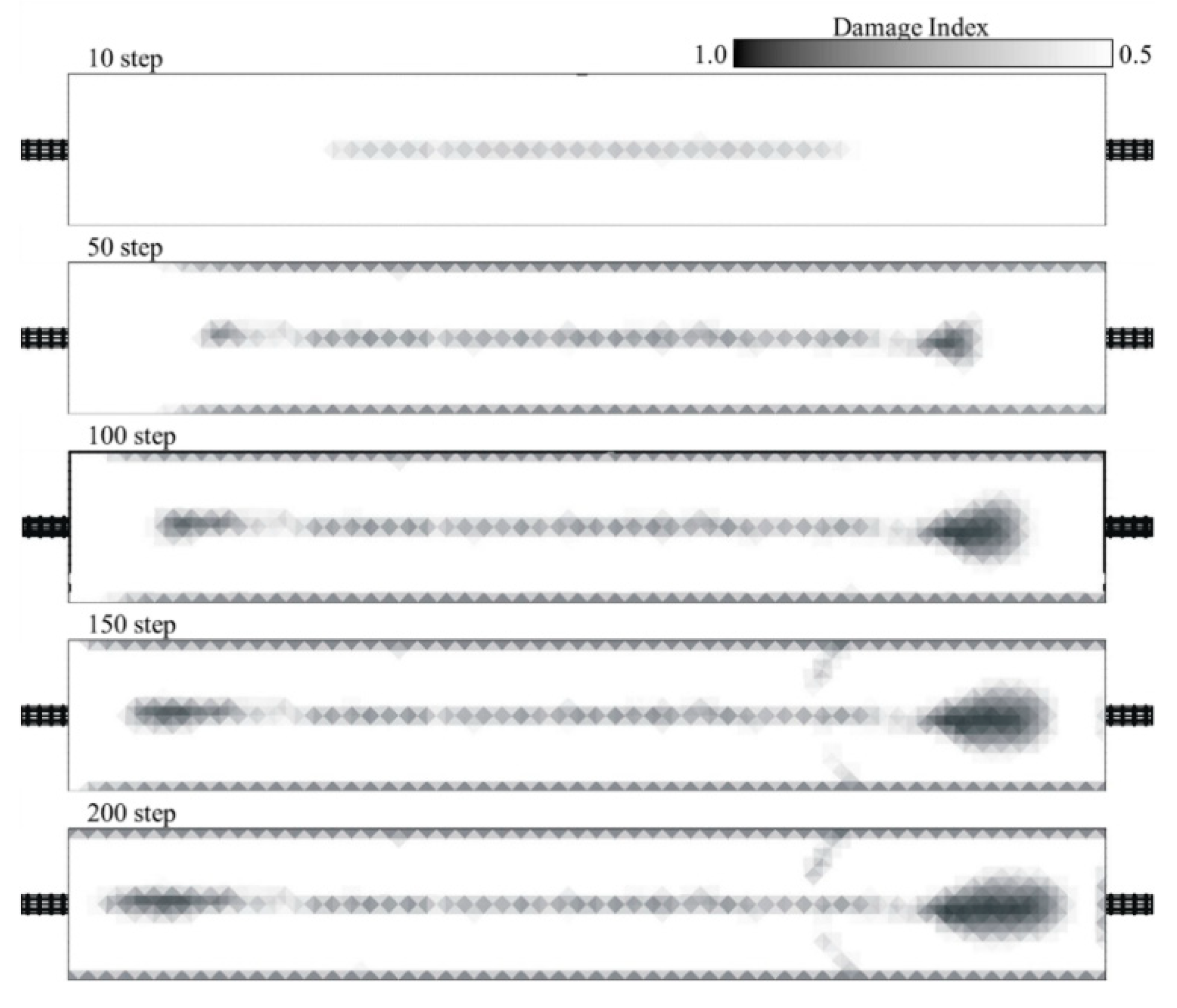
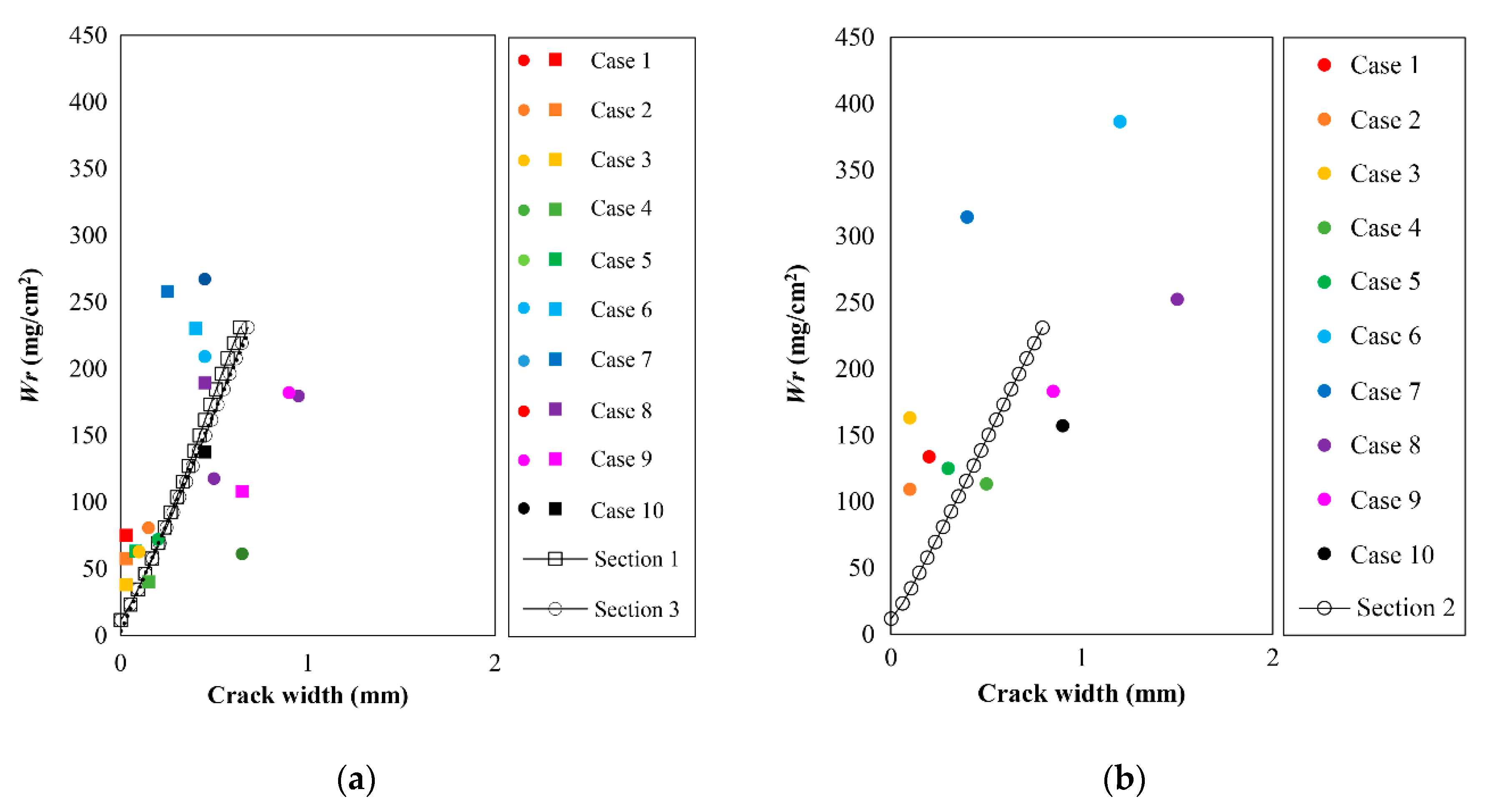
| Corrosion Amount (mg/cm2) | |||
|---|---|---|---|
| Area | 1 | 2 | 3 |
| Case 1 | 75.10 | 133.69 | 62.80 |
| Case 2 | 57.42 | 109.22 | 80.55 |
| Case 3 | 37.99 | 163.07 | 62.41 |
| Case 4 | 40.27 | 113.25 | 61.02 |
| Case 5 | 63.17 | 124.80 | 71.84 |
| Case 6 | 230.26 | 386.34 | 209.09 |
| Case 7 | 257.94 | 314.39 | 267.05 |
| Case 8 | 189.41 | 252.49 | 179.49 |
| Case 9 | 108.07 | 182.97 | 182.07 |
| Case 10 | 137.53 | 157.07 | 117.41 |
© 2020 by the authors. Licensee MDPI, Basel, Switzerland. This article is an open access article distributed under the terms and conditions of the Creative Commons Attribution (CC BY) license (http://creativecommons.org/licenses/by/4.0/).
Share and Cite
Okazaki, S.; Okuma, C.; Kurumatani, M.; Yoshida, H.; Matsushima, M. Predicting the Width of Corrosion-Induced Cracks in Reinforced Concrete Using a Damage Model Based on Fracture Mechanics. Appl. Sci. 2020, 10, 5272. https://doi.org/10.3390/app10155272
Okazaki S, Okuma C, Kurumatani M, Yoshida H, Matsushima M. Predicting the Width of Corrosion-Induced Cracks in Reinforced Concrete Using a Damage Model Based on Fracture Mechanics. Applied Sciences. 2020; 10(15):5272. https://doi.org/10.3390/app10155272
Chicago/Turabian StyleOkazaki, Shinichiro, Chisato Okuma, Mao Kurumatani, Hidenori Yoshida, and Manabu Matsushima. 2020. "Predicting the Width of Corrosion-Induced Cracks in Reinforced Concrete Using a Damage Model Based on Fracture Mechanics" Applied Sciences 10, no. 15: 5272. https://doi.org/10.3390/app10155272
APA StyleOkazaki, S., Okuma, C., Kurumatani, M., Yoshida, H., & Matsushima, M. (2020). Predicting the Width of Corrosion-Induced Cracks in Reinforced Concrete Using a Damage Model Based on Fracture Mechanics. Applied Sciences, 10(15), 5272. https://doi.org/10.3390/app10155272





